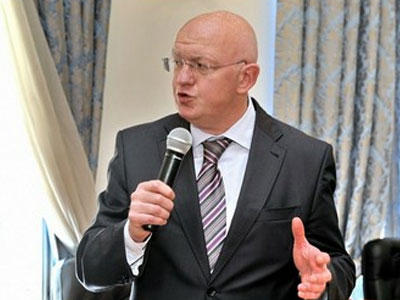Moscow sees no similarity between Crimea and Nagorno-Karabakh conflicts

By Sara Rajabova
Russia ruled out any similarities between the events in Crimea
and situation in Transnistria and Nagorno-Karabakh
"I don't see any similarity between the events in Crimea and
situation in Transnistria and Nagorno-Karabakh
He made the remarks responding to a question whether any new developments should be expected with regards to the settlement of the Nagorno-Karabakh and Transnistria issues.
Nebenzia said the OSCE Minsk Group is involved in the settlement of the Nagorno-Karabakh conflict; there are co-chairs representing Russia, France and the U.S. and they seek to promote direct dialogue between Azerbaijanis and Armenians.
The Nagorno-Karabakh conflict emerged in 1988 when Armenia made territorial claims against Azerbaijan. Since a lengthy war in the early 1990s that displaced over one million Azerbaijanis, Armenian armed forces have occupied over 20 percent of Azerbaijan's internationally recognized territory, including Nagorno-Karabakh and seven adjacent regions.
The UN Security Council's four resolutions on Armenian withdrawal have not been enforced to this day.
Peace talks, mediated by Russia, France and the U.S. through the OSCE Minsk Group, are underway on the basis of a peace outline proposed by the Minsk Group co-chairs and dubbed the Madrid Principles. The negotiations have been largely fruitless so far.
Nebenzia also stressed that CIS Council of Foreign Ministers held a meeting recently, during which Azerbaijani and Armenian foreign ministers sat for talks. Meanwhile, there was a meeting between leaders of these countries recently.
"There is also the 'five plus two' format for Transnistrian settlement and the work is underway in these directions," Nebenzia added.
In September 1990, five districts of Moldova located on the left bank of Transnistria announced the formation of a Transnistrian Union Republic within the USSR and then - independent Transnistrian Moldovan Republic (PMR) with Tiraspol as center.
Moldovan authorities did not agreed with the decision of the Transnistrian MPs and tried to solve the problem by deploying troops in the breakaway republic.
In March 1992, armed conflict broke out in Transnistria, which lasted several months, until mid-July.
As a result, Chisinau lost control of the left bank districts and Transnistria has become virtually uncontrollable by Chisinau territory, with all the attributes of statehood, including its own currency.
The armed phase confrontation ended only after deployment of the units of the Russian army in the conflict zone.
Here we are to serve you with news right now. It does not cost much, but worth your attention.
Choose to support open, independent, quality journalism and subscribe on a monthly basis.
By subscribing to our online newspaper, you can have full digital access to all news, analysis, and much more.
You can also follow AzerNEWS on Twitter @AzerNewsAz or Facebook @AzerNewsNewspaper
Thank you!
